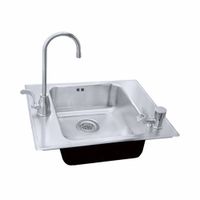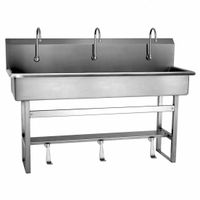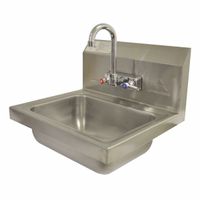Call +(254) 703 030 000 / 751 483 999 / 721 704 777
- Home
- Plumbing
- Sinks Wash Fountains Repair Parts
- Hand Sinks Hand Wash Stations
Frequently Asked Questions
What is the difference between a hand sink and a hand wash station?
A hand sink and a hand wash station both serve the purpose of facilitating hand hygiene, but they differ in design, location, and functionality.
A hand sink is a fixed plumbing fixture typically found in kitchens, bathrooms, and other permanent facilities. It is connected to the building's water supply and drainage system, providing a continuous flow of hot and cold water. Hand sinks are usually made of durable materials like stainless steel or porcelain and are equipped with faucets, soap dispensers, and sometimes hand dryers or paper towel dispensers. They are designed for frequent use and are a permanent part of the facility's infrastructure.
In contrast, a hand wash station is a portable or temporary setup that can be used in various locations, such as outdoor events, construction sites, or areas without permanent plumbing. These stations are self-contained units that include a water reservoir, a basin, and often a foot pump or hand pump to dispense water. They may also have built-in soap dispensers and paper towel holders. Hand wash stations are designed for mobility and ease of setup, making them ideal for temporary or remote locations where traditional plumbing is unavailable.
In summary, the main differences lie in their permanence, plumbing requirements, and intended use. Hand sinks are permanent fixtures with direct plumbing connections, while hand wash stations are portable, self-contained units suitable for temporary or remote use.
How do hands-free hand sinks work?
Hands-free hand sinks operate using sensor-based technology to facilitate touchless operation, enhancing hygiene and convenience. These sinks are equipped with infrared sensors or capacitive sensors that detect the presence of hands. When hands are placed within the sensor's range, it triggers the faucet to release water.
The infrared sensors emit an invisible light beam, and when hands interrupt this beam, the sensor sends a signal to a solenoid valve. This valve then opens to allow water flow. Capacitive sensors, on the other hand, detect changes in the electrical field caused by the proximity of hands, similarly activating the water flow.
The water temperature and flow rate are often pre-set or adjustable via a control panel, ensuring consistent and comfortable use. Some models incorporate thermostatic mixing valves to maintain a stable water temperature, preventing scalding.
Power for these systems is typically supplied by batteries or a direct electrical connection. Battery-operated models are advantageous in areas without easy access to electrical outlets, while hardwired models offer continuous power without the need for battery replacement.
Additionally, hands-free sinks may include features like automatic soap dispensers and hand dryers, further minimizing contact and enhancing sanitation. These systems are particularly beneficial in public restrooms, healthcare facilities, and food service environments where reducing the spread of germs is crucial.
Overall, hands-free hand sinks provide a hygienic, efficient, and user-friendly solution for handwashing, leveraging sensor technology to minimize contact and improve cleanliness.
What are the benefits of using hands-free hand wash stations?
Hands-free hand wash stations offer numerous benefits, enhancing hygiene, convenience, and sustainability. Firstly, they significantly reduce the risk of cross-contamination and the spread of germs. By eliminating the need to touch faucets or soap dispensers, these stations minimize contact with surfaces that can harbor bacteria and viruses, promoting better public health.
Secondly, hands-free stations are more convenient and user-friendly. They often feature motion sensors that automatically dispense soap and water, making them accessible for people of all ages and abilities, including those with mobility challenges. This ease of use encourages more frequent handwashing, which is crucial for maintaining hygiene.
Additionally, these stations contribute to water conservation. Many hands-free systems are designed to dispense a controlled amount of water, reducing wastage compared to traditional taps that may be left running. This efficiency not only conserves water but also lowers utility costs, making them economically beneficial for businesses and public facilities.
Moreover, hands-free hand wash stations are often more durable and require less maintenance. With fewer moving parts and no need for manual operation, they are less prone to wear and tear, reducing the frequency and cost of repairs.
Finally, they enhance the user experience by providing a modern and aesthetically pleasing design. This can improve the overall ambiance of a facility, whether in a commercial, educational, or healthcare setting, and reflect positively on the establishment's commitment to hygiene and customer care.
In summary, hands-free hand wash stations offer improved hygiene, convenience, water conservation, durability, and aesthetic appeal, making them a valuable addition to any environment focused on health and efficiency.
How do you maintain and clean hand sinks in healthcare facilities?
To maintain and clean hand sinks in healthcare facilities, follow these steps:
1. **Daily Cleaning**: Use a hospital-grade disinfectant to clean sinks at least once daily. Focus on high-touch areas like faucet handles and soap dispensers.
2. **Routine Inspection**: Regularly inspect sinks for leaks, clogs, or damage. Ensure that water flows properly and drains efficiently.
3. **Disinfectant Use**: Apply disinfectant to all sink surfaces, including the basin, faucet, and handles. Allow the disinfectant to sit for the recommended contact time before wiping it off.
4. **Non-Abrasive Cleaners**: Use non-abrasive cleaners to avoid scratching surfaces, which can harbor bacteria.
5. **Avoid Cross-Contamination**: Use color-coded cleaning cloths and tools to prevent cross-contamination between different areas.
6. **Hand Hygiene Supplies**: Ensure soap dispensers are filled and functioning. Use touchless dispensers if possible to minimize contact.
7. **Paper Towel Dispensers**: Keep paper towel dispensers stocked and ensure they are functioning properly.
8. **Regular Maintenance**: Schedule regular maintenance checks for plumbing and fixtures to prevent issues that could lead to contamination.
9. **Signage**: Post clear handwashing instructions near sinks to encourage proper hand hygiene practices.
10. **Staff Training**: Train staff on proper cleaning protocols and the importance of maintaining clean sinks to prevent infection.
11. **Waste Disposal**: Ensure waste bins near sinks are emptied regularly to prevent overflow and maintain cleanliness.
12. **Record Keeping**: Maintain logs of cleaning schedules and inspections to ensure compliance with healthcare standards.
By following these steps, healthcare facilities can ensure that hand sinks remain clean and functional, supporting effective infection control practices.
What are the regulations for hand sinks in food service facilities?
Hand sinks in food service facilities must comply with specific regulations to ensure hygiene and prevent contamination. These regulations typically include:
1. **Location**: Hand sinks must be conveniently located in food preparation, service, and dishwashing areas to encourage frequent handwashing. They should be easily accessible to all employees.
2. **Number**: Facilities must have an adequate number of hand sinks based on the size and layout of the operation to prevent delays in handwashing.
3. **Water Supply**: Hand sinks must be supplied with hot and cold running water under pressure. The water temperature should be at least 100°F (38°C) to ensure effective handwashing.
4. **Soap and Drying**: Hand sinks must be equipped with a supply of hand soap and a sanitary method for drying hands, such as disposable paper towels or hand dryers. Reusable towels are not permitted.
5. **Signage**: Clear signage must be posted at hand sinks to remind employees to wash their hands. This is often a regulatory requirement to reinforce hygiene practices.
6. **Use**: Hand sinks are designated solely for handwashing and must not be used for other purposes, such as washing utensils or food.
7. **Maintenance**: Hand sinks must be kept clean and in good working order. They should be free of obstructions and accessible at all times.
8. **Waste Disposal**: Proper drainage and waste disposal systems must be in place to handle wastewater from hand sinks.
9. **Compliance**: Facilities must comply with local health department regulations, which may vary by region. Regular inspections ensure adherence to these standards.
These regulations are designed to promote food safety by ensuring that employees can wash their hands effectively and frequently, reducing the risk of foodborne illnesses.
How do you prevent cross-contamination with hand sinks?
To prevent cross-contamination with hand sinks, ensure the following practices:
1. **Dedicated Use**: Designate hand sinks exclusively for handwashing. Avoid using them for food preparation, dishwashing, or cleaning tools.
2. **Proper Location**: Install hand sinks in accessible areas near food preparation and service areas to encourage frequent use by staff.
3. **Adequate Supplies**: Equip sinks with antibacterial soap, disposable towels, or air dryers. Ensure these supplies are regularly restocked.
4. **Hands-Free Operation**: Use hands-free faucets, such as foot pedals or sensor-activated taps, to minimize contact and reduce contamination risk.
5. **Regular Cleaning**: Clean and sanitize hand sinks frequently to prevent the buildup of bacteria and other pathogens.
6. **Clear Signage**: Post clear instructions and reminders about proper handwashing techniques and the importance of using the sink only for handwashing.
7. **Training**: Educate staff on the importance of hand hygiene and the role of hand sinks in preventing cross-contamination. Conduct regular training sessions.
8. **Monitoring and Enforcement**: Implement a system to monitor handwashing practices and ensure compliance. Address any lapses immediately.
9. **Separate Waste Disposal**: Provide a separate waste bin for used towels near the sink to prevent contamination from waste materials.
10. **Avoid Splashing**: Design sinks to minimize splashing, which can spread contaminants. Use splash guards if necessary.
By following these practices, you can effectively prevent cross-contamination and maintain a hygienic environment.
What materials are best for hand sinks in cleanrooms?
The best materials for hand sinks in cleanrooms are stainless steel, polypropylene, and epoxy resin.
Stainless steel is highly favored due to its durability, corrosion resistance, and ease of cleaning. It is non-porous, which prevents microbial growth, and can withstand frequent cleaning with harsh chemicals. The smooth surface of stainless steel minimizes particle shedding, making it ideal for maintaining the stringent cleanliness standards required in cleanrooms.
Polypropylene is another excellent choice, particularly for environments where chemical resistance is crucial. It is lightweight, durable, and resistant to a wide range of acids and bases. Polypropylene sinks are also non-porous, reducing the risk of contamination and making them easy to clean and maintain.
Epoxy resin is used for its chemical resistance and durability. It is non-porous and can withstand exposure to a variety of chemicals without degrading. Epoxy resin sinks are also resistant to heat and impact, making them suitable for cleanrooms where thermal and mechanical stresses are present.
All these materials are chosen for their ability to maintain cleanliness, resist contamination, and endure the rigorous cleaning protocols of cleanroom environments.


